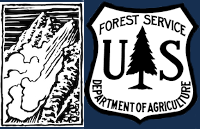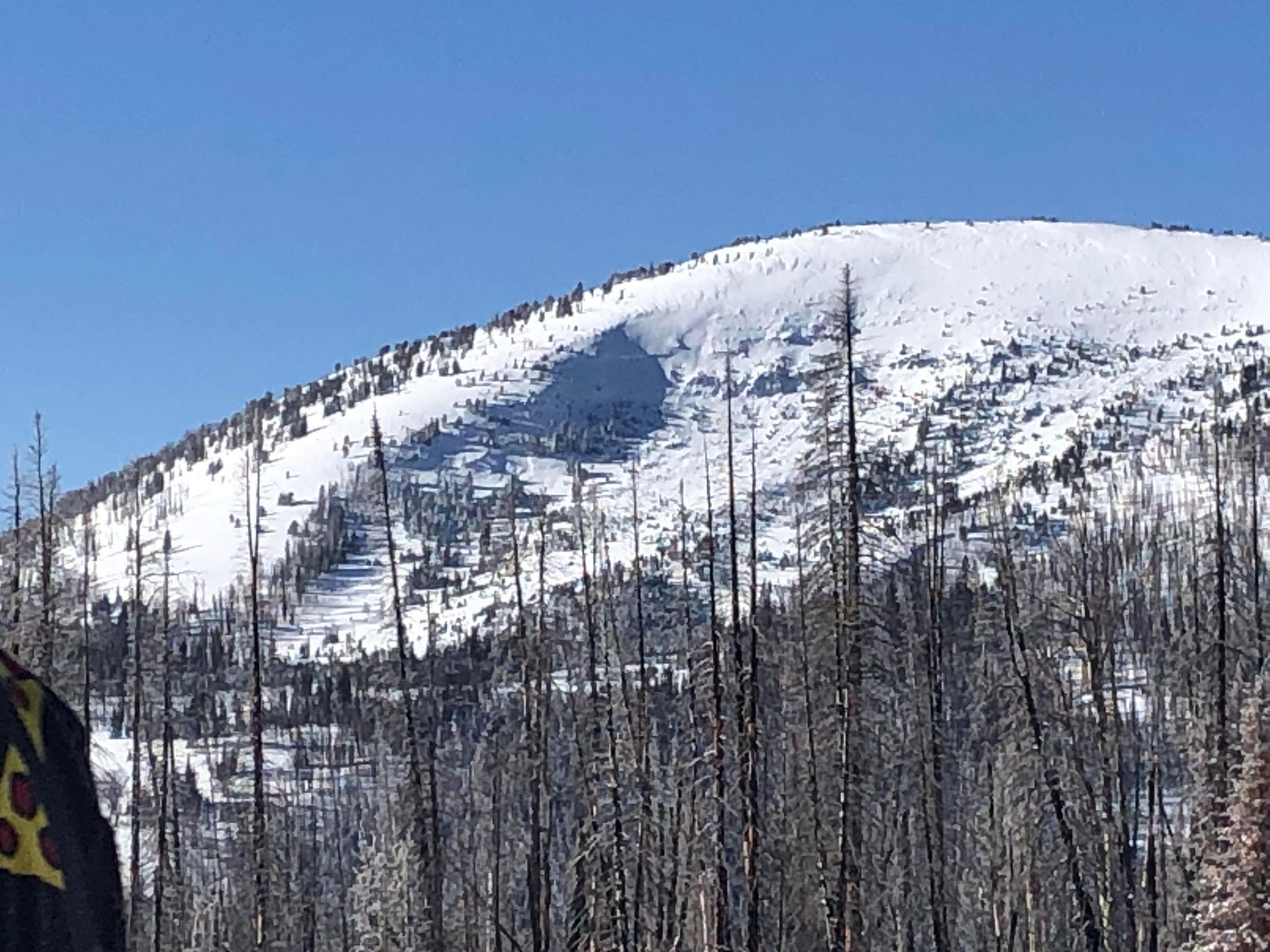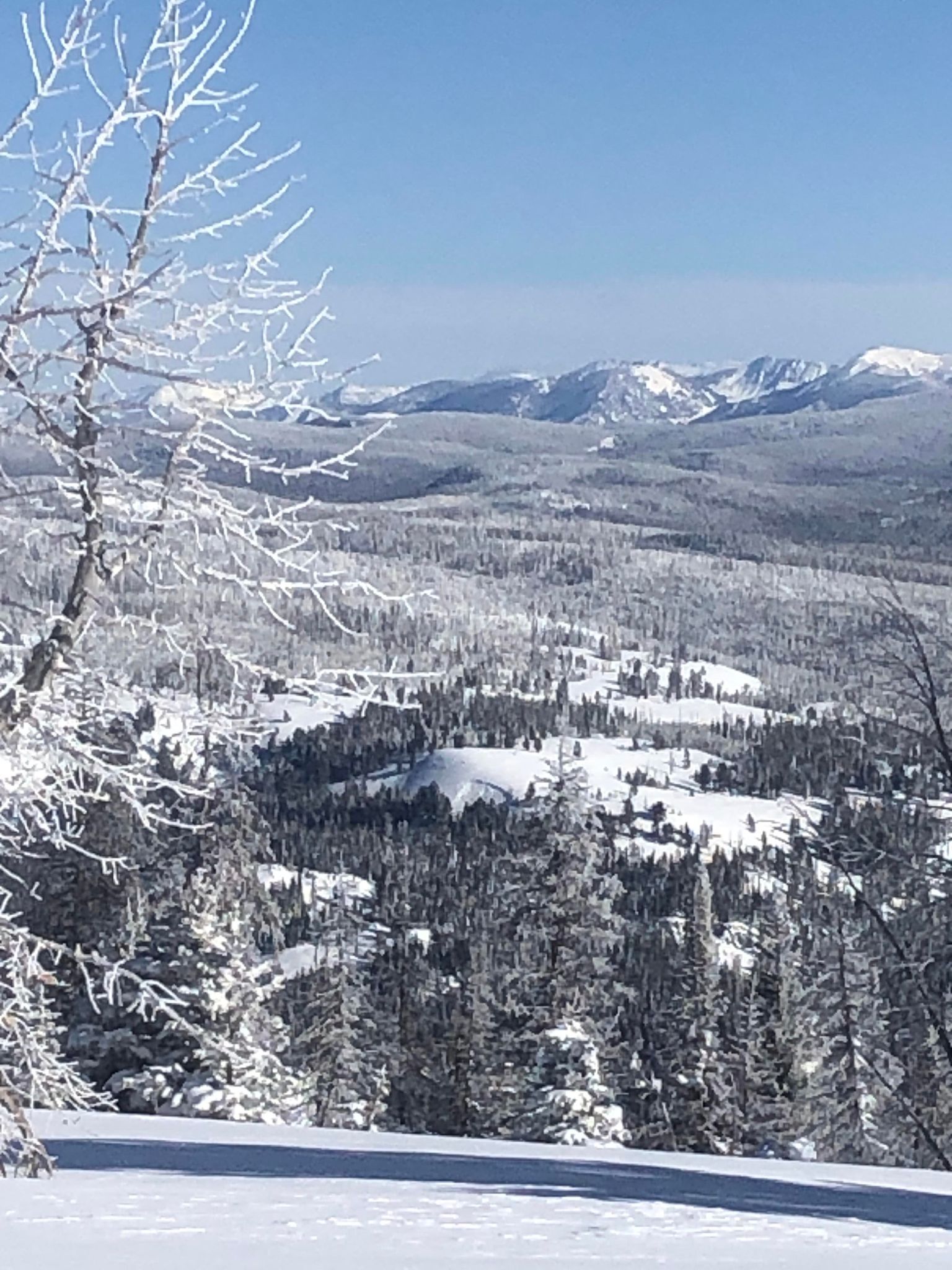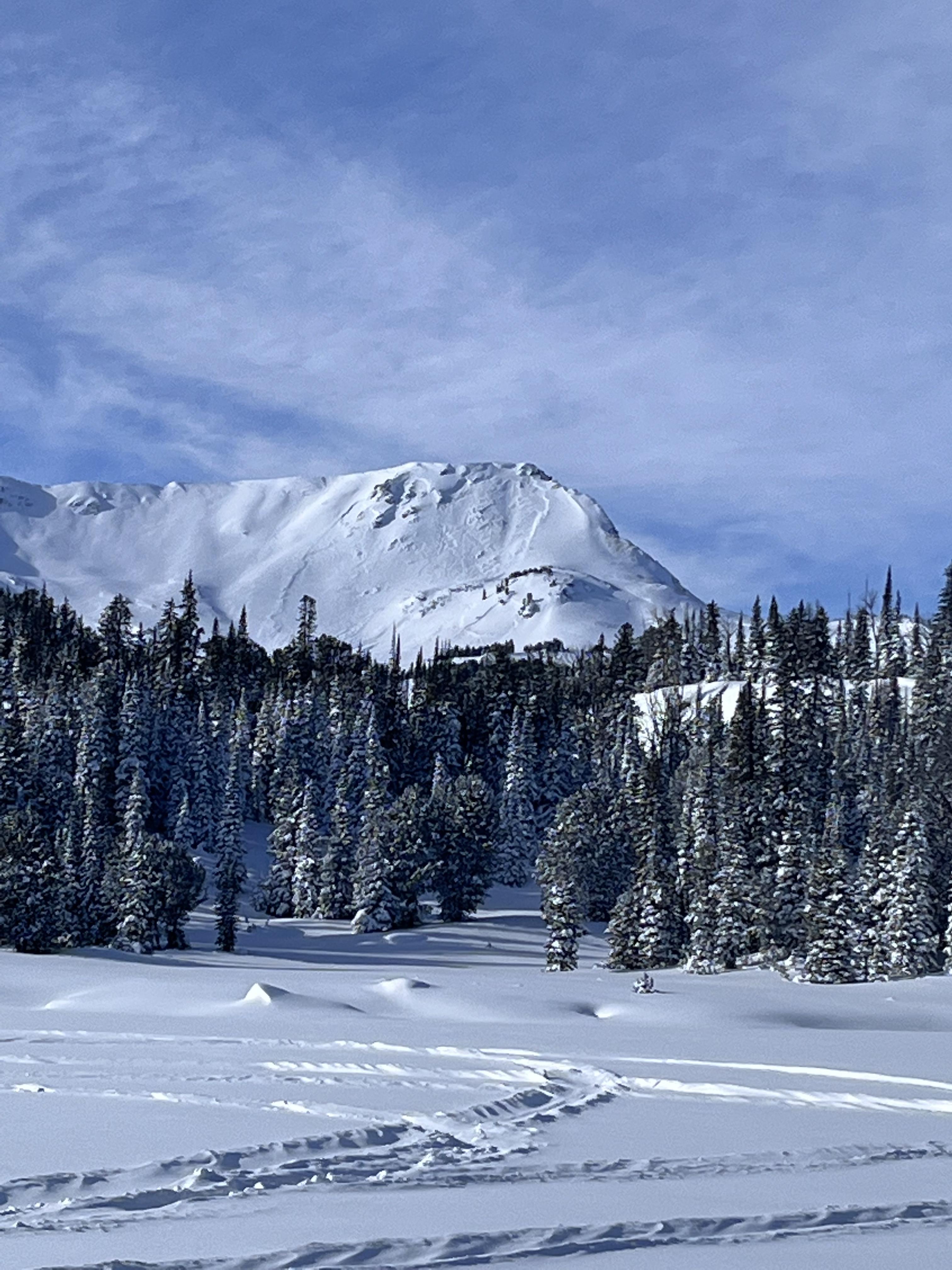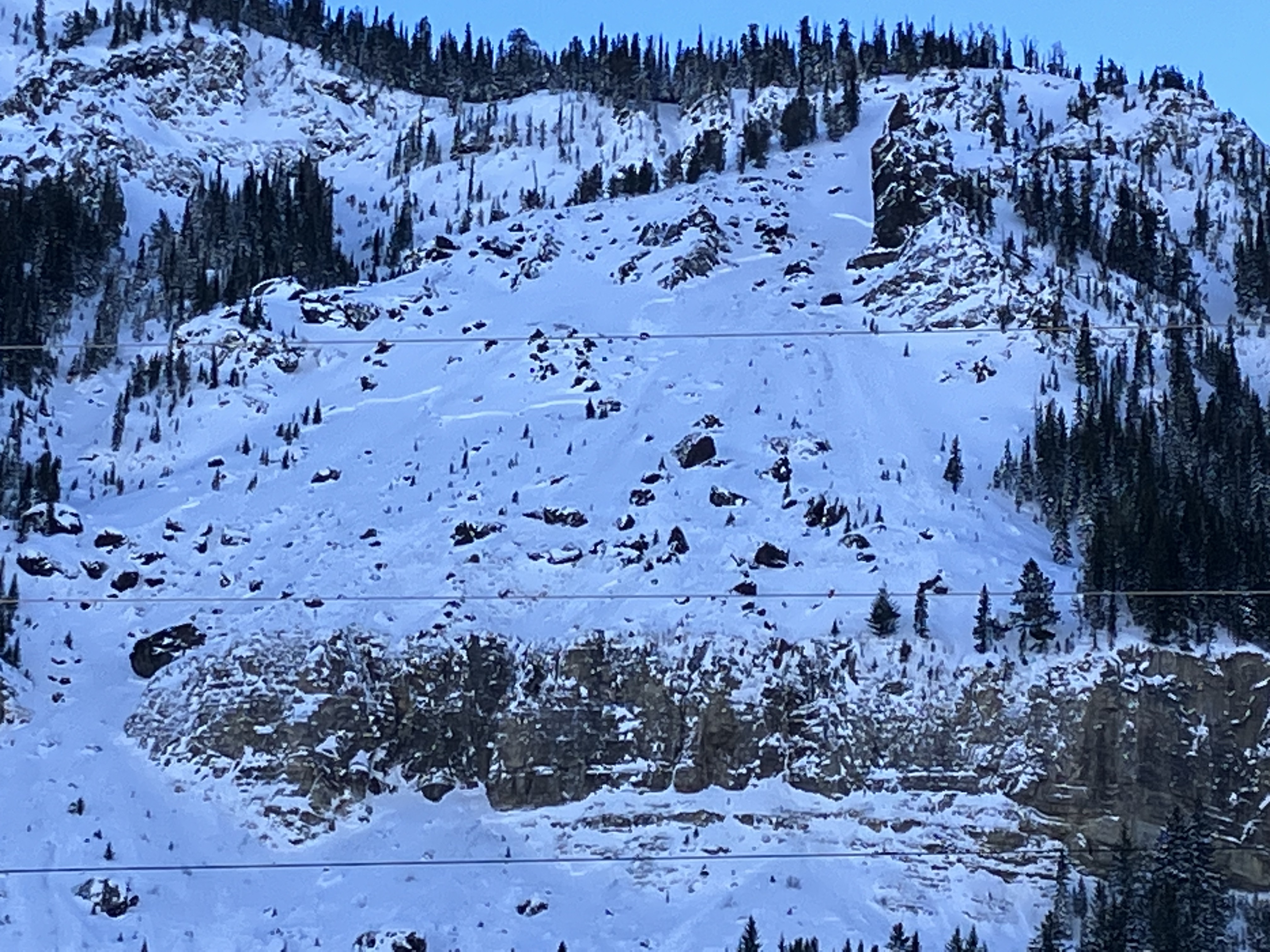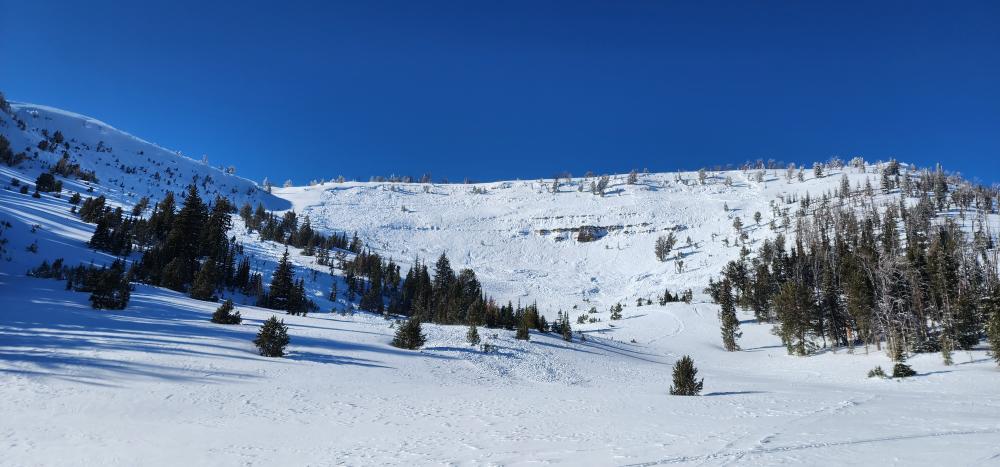Snow Observations List
Two skiers triggered an avalanche while ascending the Banana Couloir on Ross Peak on the morning of 12/5/22. The skiers were approximately 150 ft from the top of the couloir when the avalanche broke 20 ft above the upper skier. The slide broke in wind drifted snow 6 inches deep and approximately 30 ft wide, across most of the couloir. The lower skier was waiting in a "safe spot on the side" but was also caught by the slide. The slide ran ~600 vertical feet, pulling out a deeper pocket of snow (1.5-2 ft deep) midway down the path. Both skiers were fully submerged as they were carried, but ended up partially buried near the toe of the debris. One skier had snow packed into his mouth and underneath his eyelids. They returned to the trailhead under their own power.
Full Snow Observation ReportFound facets sitting beneath a crust 60cm from the ground. Observed collapse on this layer in our pits but no propagation.
Full Snow Observation ReportSmall avalanche below Henderson Bench. SE aspect. Likley Snowmobile-trigger did not confirm. 70-90’wide, 1-3’ crown, ran 40’
Full Snow Observation ReportSnow pack of 108cm on a 25 NE facing slope at 9,625'
Observed CT11 Q2 at new/old interface, 93cm, as well as an ECTN13 Q2 on what we believe to be a buried layer of surface hoar at 26cm. Also had some warming of the surface.
With the poor pit performance we decided to not ascend to the ridge and ski the intermediate terrain in the cirque, then out the drainage.
Full Snow Observation ReportHere’s an avalanche we saw on December 2nd 2022 in cooke city on the north side of Henderson mountain just above lulu road.
Full Snow Observation ReportI toured in Lick Creek yesterday and thought I'd share a few things we noticed. Hopefully they are helpful observations!
While the skin track was still relatively flat and cutting through sloping meadows, we noticed a small sun crust on a southern aspect.
As we skinned through the front side skiing zone, we noticed evidence of wind affected snow. We found some strong layers that sounded hollow, sometimes underneath ~2 inches of snow. As we gained the ridgeline, the wind slab became more obvious. It cracked under my weight, but I didn't see any shooting cracks or distinct collapses.
Full Snow Observation ReportToured up to Bacon Rind today and skied meadows off of the ridge. Noted many collapses and whumpfs in the snowpack as we ascended east aspects to the ridge. Looking toward Ernie Miller ridge, we noted an old crown in the main bowl just below the summit. It was on an E-NE aspect, 200 or more feet wide and looked to be filled in with new snow but was still visible. Looking east from the top of the ridge, we noted another crown on a west aspect that looked to be about 100' wide and deep.
Dug a pit at 8700' on a W aspect. HS was 70cm. We got an ECTP12 45 cm up from the ground at the interface between wind packed snow and a layer of .5-1mm facets and mixed forms. That layer made up the bottom 45cm of the snowpack in that area.
Dug another pit at 8800' on an E aspect. HS was 115cm. We got an ECTP 14 50cm up from the ground on that same interface as described above. The bottom 50cm of the snowpack looked to be facets and mixed forms. The upper 65cm in that area was a mixture of different layers of wind packed grains that ranged from F to 4F hardness.
Coverage on the descent is adequate, similar if not better than any point midwinter last season. Under skis, the snow in the burn/forest feels unconsolidated and very sugary.
Full Snow Observation ReportEarly season snow recon outside of Maverick Mountain Ski Area boundary. Cracking of surface slab on easterly aspect at 8000 ft (see pics). Well developed weak layer about mid-pack that formed during November. Several storms the first week of December put down a 1-2 foot slab on top of this weak layer. Cohesiveness of slab varies by aspect and elevation. Wind and sun exposed slopes more reactive due to higher slab density. Areas protected from wind were not as reactive with no cracking experienced. Spatial variability is high with a shallow snowpack. See picture of quick pit showing major layering on north facing aspect at 8400 ft. Height of snow between 65-75 cm. Notable results were CTM 11 with a sudden collapse fracture character at 35cm up from the ground at November/December snow interface. ECTN 11 on same layer. The slab was not stiff enough in this protected location to propagate however this pit is representative of poor structure that is widespread.
Also, snowmobilers reported avalanches on some of the steep roadcuts on the Pioneer Scenic Byway.
Full Snow Observation ReportLarge collapses on primarily solar aspects (S/SE, ~9,500’)
Ectx results on a north facing slope ~9,500’
Full Snow Observation ReportAt the saddle between the front and backside of Lick Creek we found 110cm of snow with very dense windslabs. These were firm and cohesive, with the firmest being between 100 and 90cm. Our layer of most concern was at 65cm but was difficult to impact and we felt confident our weight alone even in shallow areas would not impact this layer, we skied the front side however due to time constraints.
Full Snow Observation ReportWe toured to Ernie Miller today and saw a natural avalanche on a NE slope around 9600 ft. We heard and felt multiple collapses on our way in. We dug a pit on an east facing slope around 9300 ft where we found 105 cm of snow. We got a ECTN 2 result, failing on an interface about 15cm from the surface and ECTP5 failing 40 cm from the surface.
Full Snow Observation ReportFrom IG 12/3: Hey guys, just getting back from Cooke. Confirming more of what you saw, lots of large natural avalanches up high. Most notable was this massive slide on fox, looks to have broke 2-6’ deep and over 1000’ wide. Couldn’t quite see the toe from our tour but it looked to have run over 1000’ vertical. Never have seen one so large on Fox… we stuck on sub 25° terrain which was hard to move in. Lots of whumphing but not much (if any) cracking...
Full Snow Observation ReportWe dug a pit on a W/WNW slope at around 9100 ft in the republic creek drainage. CT 18 and ECTN34 (ECTX then we hit it extra hard 4 more times) on the weak layer about 70 cm down. But overall snowpack was upright and it seemed to be settling down more than we thought. But then as we approached the ridge we triggered 5 separate large collapses ("Whumphs"), all on WSW/SW slopes (between 8700 and 9200 ft). Pole probes revealed a light crust about 12 inches down.
Full Snow Observation ReportFrom IG 12/3: It was natural. Happened last night or this morning. It hadn't slid when we left yesterday. We were first tracks in today, and there were no tracks above or below this slide. Crown at the peak was around 6'. Average 2-3' crown. 10' debris piles at least.
Full Snow Observation Reportskied over by slush mans lift yesterday.
Got some settling on lower angle above base of lift.
Full Snow Observation ReportWe observed no natural avalanches or overt signs of instability, although one group in the parking lot mentioned seeing a small slide south in Sage Basin past the Otter Slide. The foot of new snow was wind affected. Human-triggered avalanches in the new snow and wind slabs were possible. These will stabilize in the next few days unless there is continued loading.
We dug in Carrot Basin and on the slope up to the weather station. We did not find the weak layers of surface hoar or near-surface faceting like at Lionhead Ridge. I am not convinced it doesn’t exist anywhere, but it does not appear to be widespread. Test results were ECTN 11-15 under the foot of new snow.
Full Snow Observation Report
